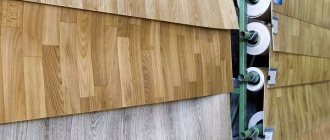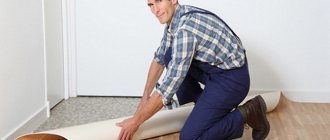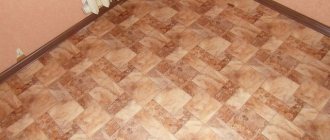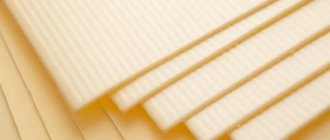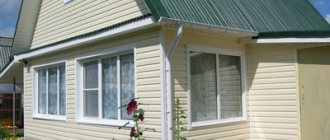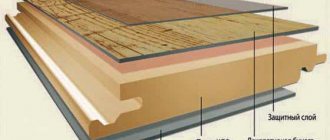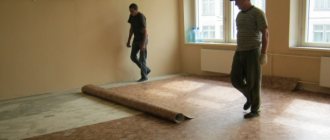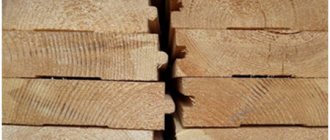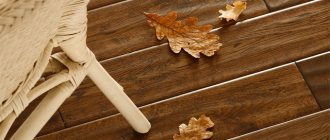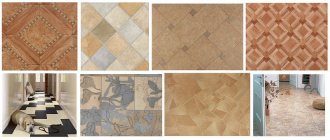Linoleum is considered a practical and relatively inexpensive flooring. A wide selection of colors and patterns, the ability to imitate any finishing materials give it additional popularity. Since budget coatings are usually preferred by buyers who want to do the repairs themselves, they inevitably face the question of how to lay linoleum correctly so as not to have problems in the future.
Laying linoleum on a concrete floor
As in the situation with wooden floors, installation is carried out after all repair work has been completed, the room is completely ready and the material has been pre-matured in a rolled out state. Linoleum is laid on a leveled and clean subfloor.
Floor preparation
Leveling a concrete floor for laying linoleum is much easier than leveling a wooden one. Uncorrected surface defects are visually noticeable on the coating and lead to abrasion of the top layer. Before laying linoleum, check the strength of the screed. If the screed is loose, it should be replaced. If the quality of the screed is good, it is enough to level the base with leveling mixtures, plywood, chipboard or by arranging a dry screed.
Preparatory steps for leveling the screed with mixtures:
- The old floor covering is dismantled.
- All bumps or sagging are removed from the concrete base by grinding.
- Cracks or potholes are repaired using leveling mixtures.
- The surface is sanded, dust-free, and treated with a primer.
Important: you should not make the surface too smooth, this reduces the quality of adhesion to the coating.
The thickness of the leveling layer in the presence of freshly repaired damage must be at least 5 mm. After leveling, the maximum permissible deviation of the floor surface from the horizontal in length or width is 0.2% of the corresponding linear dimension. The clearance between the floor surface and a 2 m long batten is no more than 2 mm. Work begins when the screed humidity is no more than 5%.
Laying linoleum
The processes for laying linoleum on wood and concrete floors are similar, but on a concrete base, linoleum without a base will definitely require a backing. The main functions of the substrate are noise and heat insulation of the floor. Additionally, the substrate will help eliminate minor surface defects, but you should not count on leveling out large flaws.
As a substrate, roll materials made of foamed polyethylene, cork, jute, flax, wool are used, and there are combined options. Substrates made from natural materials are more environmentally friendly and do not shrink.
Types of linoleum
When coming to the store, many people are confused by the variety of floor coverings. Before laying linoleum in your home, study its types.
Natural
It is made from natural ingredients - cork chips, linseed oil, wood resins and natural dyes. The heated composition is impregnated with a base of jute, flax or hemp fibers.
Natural linoleum is highly resistant to abrasion and fading, does not support combustion, and does not emit unpleasant odors. The coating retains its color brightness for up to 20 years, and can last even longer.
But the natural material becomes brittle at low temperatures, is susceptible to rotting and is quite expensive, which limits its use. However, this is the most environmentally friendly of all types of linoleum, which can be used in all residential areas without exception.
PVC linoleum
Floor coverings of this type are made of polyvinyl chloride. They can contain from 1 to 6 layers, without a base or contain a base of fiberglass, PVC foam, synthetic or natural fabric.
Single-layer homogeneous materials are extremely resistant to abrasion and are used in high-traffic areas. The pattern permeates the entire thickness of the coating, so abrasions are hardly noticeable.
In multilayer linoleum, the pattern is applied to the surface, so damaged areas quickly become visible. But such coatings, compared to single-layer ones, have higher heat and sound insulation properties.
PVC linoleum is environmentally friendly, unlike natural linoleum it does not rot, is not affected by fungi and is several times cheaper. Can be used in damp areas, but is afraid of heating.
Relin
This type of linoleum is made from rubber or caoutchouc. It is characterized by high abrasion resistance, good antistatic and anti-slip properties, and hygiene. In our country, the production of relin has not been established; the material is imported from Europe and America, so its price is quite high.
Rubber linoleum is used in medicine as a covering for operating rooms, in the sports industry, and in educational institutions. For use in chemically aggressive environments, special Relin is produced with the addition of stable elastomers.
Nitrocellulose linoleum
Coatings of this type are made from colloxylin, an artificially created polymer with a loose fibrous structure. The material is elastic, moisture-resistant, and retains its shine for a long time.
Nitrolinoleum is produced mainly in red-brown colors in the form of single-layer coatings of small thickness. It is sensitive to temperatures above 40° and below 10°, solvents and ultraviolet radiation. Due to the high fire hazard, it is not recommended for use in children's institutions and residential premises.
Alkyd linoleum
The material is made from modified alkyd (glyphthalic) resins with mineral and organic fillers, applying them to a fabric base. The design is created by surface printing or by adding colored pigments to the mass.
The advantages of alkyd linoleums are heat resistance, resistance to aging, high sound and heat insulation properties. But the fabric base is afraid of water and quickly rots, so such coatings are not used in damp rooms. In addition, the canvas is prone to shrinkage and cracking, which must be taken into account when laying.
How to connect joints: cold and hot welding method
The seams are welded no less than 1–3 days after gluing the linoleum; the exact holding time depends on the type of glue and the manufacturer’s recommendations. Welding protects the seams from contamination and moisture penetration under the coating. There are two welding methods - cold and hot.
Hot welding uses a thermal contact connection method using a self-propelled welding machine in automatic mode or a manual welding gun. In wet rooms or in the presence of a heated floor system, only this method is used for joining seams. Cold welding is performed chemically using a special glue; it is recommended for creating continuous coatings on a large surface area.
Cold welding stages:
- After cutting the canvases, paper tape is glued along the joint line to protect the glue from spreading. The tape is cut along the seam with a knife with a trapezoidal or disk blade. Another option is possible - gluing two tapes side by side right along the edge of both canvases.
- Shake the tube of glue well, press the needle deeper into the seam and pass along the seam, filling it with glue. The pressure on the tube should be such that a strip of glue about 5 mm wide is formed on the tape.
- After 10 minutes, the tape with excess glue is removed. The resulting seam is almost invisible.
Hot welding steps:
- At the joints of the canvases, seams 2–3 mm wide are cut with an electric milling cutter or furrow maker.
- The seam is cleaned of dirt and the welding cord is laid using a welding machine or hairdryer. Before starting work, it is recommended to make a test pass to set the optimal temperature and welding speed.
Preparation for installation
To understand how to lay linoleum correctly, you need to carefully study all stages of the work. The material purchased and delivered to the site is spread out and allowed to rest for at least 2 days at a temperature of +18 degrees and above. This will help level the linoleum and eliminate the possibility of unevenness and waves in the future.
Floor marking
In a large room where linoleum is laid in strips, all purchased rolls are rolled out, pressed with a certain amount of force onto the prepared floor with a soft-bristled brush, and the pattern is carefully matched along the edges of all adjacent strips. Plain material is laid in the direction of the incident light. But it is better to lay a covering with a pattern across the room in order to more accurately hide the joints and highlight the beauty of the design.
How to prepare the floor and linoleum for installation:
- Clear the room of furniture and anything that might get in the way.
- Level the linoleum: spread it out, let it lie for an hour or two, then inspect it again.
- Trim the excess with a sharp stationery knife along the ruler, taking into account a small allowance of about 5 centimeters. Only after re-measuring can you cut to size.
- There should be a gap of 5 millimeters between the wall and the edge of the linoleum.
Laying linoleum with a base without glue
When wondering how to properly lay linoleum on concrete without glue, you must remember that this option is only relevant for small rooms. After letting the rolled material rest, it is cut around the perimeter of the room, checking the cut lines with a ruler.
The cut pieces of material are laid out, aligned with the starting wall (anyone can stick it out). An overlap of 8 centimeters is made on the wall, then it is covered with baseboards and door sills. The soft base will not allow the coating to move or move in waves.
Laying linoleum with a base using glue
To glue linoleum to a concrete surface, a variety of options are used - special water-dispersed adhesives, bitumen mastics, etc.
Mastics
Often mastics are used for laying linoleum on concrete - they are moisture-resistant, durable, and can simultaneously act as waterproofing. You can prepare the mixture yourself or buy it ready-made. The type of mastic is selected in accordance with the material from which the linoleum base is made.
Most often, mastics based on bitumen and rubber are used. Many of them are universal, suitable for different types of linoleum. The composition of rubber, for example, includes the following components: synthetic resins, rubber, solvent, antiseptic. This mastic is suitable for rubber, killoxylin linoleum, and PVC coatings.
The main advantages of rubber mastic: frost resistance, antiseptic properties, waterproofing, resistance to moisture, deformation, loads, durability (up to 25 years on average), tensile strength, simplicity and comfort in operation, low cost. Mastic consumption is 0.5-1 kg/m2, shelf life is 2-6 months.
How to apply mastic:
- Thoroughly clean the floor in advance, removing dirt, debris and dust.
- Apply a thin layer of primer.
- Using a spatula, apply the mastic in a continuous layer or along the perimeter using a mesh. Tip: 2 layers of mastic are applied to the porous base.
- Laying linoleum.
Seam processing
No later than 15 minutes after hot welding the seam, you must remove the excess welding cord, otherwise the cord will cool and harden, and the cut will not come out neat and clean. Excess is removed in two steps. Initially, the cord is cut with a knife with a sled, leaving a small part above the surface. The second pass is to make a finishing cut with a sickle-shaped knife, holding the cutting edge at an angle. Finally, the seam is polished with mastic.
After cold welding, wait until the glue polymerizes and clean the seam with soft abrasives. The protective masking tape is removed from the joint after the seam has been completely processed.
Calculation of the required amount of material
Having decided on the characteristics of the material, you should calculate the required amount of coating. Modern manufacturers produce linoleum in widths from one and a half to five meters in increments of 0.5 m. If the size of the room allows, it is worth choosing linoleum that will cover the floor with one sheet, without joints. In this case, you will not have to combine the pattern on adjacent strips, that is, material savings will be achieved. In addition, the absence of unnecessary joints will provide the coating with an ideal appearance.
Measurements of length and width should be made between opposite walls in several places, taking the largest distance for further calculations. When measuring, the dimensions of technological niches should be taken into account, and the depth of all recesses is added to the total width of the room. To the results obtained, add 5 cm of overlap for each wall. For example, if the room dimensions are 8 m long and 6 m wide. Taking into account the overlap, the required coverage area will be 8.1 x 6.1 = 49.41 sq.m. You should round up. If saving material is in the foreground, the dimensions of technological niches can be ignored; in this case, they will be covered with separate pieces of material, and the joints can be welded or disguised with decorative thresholds.
Having calculated the total area of the required material, you should convert square meters into linear meters, which will allow you to determine the required number of rolls. The linoleum footage is calculated as follows:
- To determine the number of strips required for covering, the width of the room is divided by the width of the selected linoleum. Most likely, the value will be inaccurate; it should be rounded up. For example, with a room width of 6 m and a roll width of 4 m, you will need 6/4 = 1.5 strips, that is, rounding up, 2 strips of material.
- After this, the size of the length of the room is multiplied by the required number of stripes, the result in this case is rounded up.
- An overlap of 5 cm is added to the result obtained.
When making calculations, the need to join the pattern should be taken into account. The pattern on linoleum has a step length similar to, for example, repeat on wallpaper. For correct joining, an amount of material equal to the step length of the pattern should be added to the length of each canvas, including this data in the final calculation.
How to properly care for linoleum
Linoleum is washed from dirt with a rag, a soft brush or a washing vacuum cleaner. As detergents, use a soap solution or warm water with a temperature of no more than +40 °C. Do not use solvents or abrasive cleaners for cleaning.
Care Tips:
- Contact of the coating with the rubber is undesirable. Traces of shoe polish or bitumen-containing substances must be removed immediately, otherwise stains may remain on the linoleum.
- To protect against mechanical damage, place gaskets or put on protective caps under furniture legs.
- To protect the linoleum from abrasion by sand or pebbles brought in from the street, mats or gratings are placed at the entrance.
Criteria for choosing linoleum
The construction industry produces various types of linoleum from natural or polymer components. The pattern on the surface can imitate parquet, tiles, mosaics. Designers have developed incredibly realistic coatings with a 3D effect, depicting grass, stones, and water surfaces.
When choosing, the following are taken into account:
- appointment;
- requirements for temperature and moisture resistance;
- decorativeness;
- anti-slip properties;
- antistatic;
- resistance to UV rays;
- degree of flammability;
- resistance to scratches and stain-forming substances;
- ease of care;
- possibility of combination with “warm floor”;
- wear resistance;
- abrasion group.
The last 2 characteristics are especially important, since they determine what loads the coating is designed for.
How much does the material and labor cost?
The price of the material depends on the type of linoleum and wear resistance class. In residential premises, household or semi-commercial linoleum is more often used. The average price of household samples is 300–400 rub./m2, semi-commercial – 400–500 rub./m2.
The cost of laying linoleum depends on the list of preparatory work and the area of the room. In most cases, for Moscow or the Moscow region, a turnkey package of work, which includes preparing the old floor, laying the covering and installing skirting boards, costs around 600 rubles/m2.
Often you have to deal with a situation where the price of installation changes during the execution or after completion of the work. To avoid getting into an unpleasant situation, before ordering services you need to study the price list, clarify unclear points and conclude a detailed agreement.
Price and reviews about linoleum
The price of linoleum is considered affordable in comparison with other types of flooring materials: laminate, parquet boards, carpet. The cost adds up and depends on a number of factors:
- manufacturing companies Tarkett, Juteks, Grabo, Gerflor, etc.;
- types of coating;
- fabric structure;
- the presence of a base-substrate;
- canvas dimensions.
The long history of linoleum has always kept it among the most acceptable materials for flooring. To this day, interest in the canvas continues. Consumer reviews indicate that in the world of renovation there remains a need for practical linoleum that embodies comfort.
